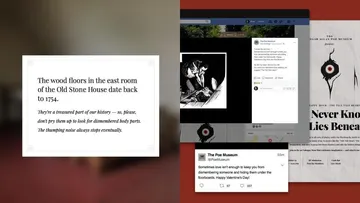On View: Why Museums Need Brand Strategy

Elyse Kamibayashi, Former Senior Brand Strategist
Article Categories:
Posted on
Museums are essential to our communities — but should brand strategy be essential to museums?
In 2000, the Tate Gallery (which encompasses the Tate Britain, Tate Modern, Tate Liverpool, and Tate St Ives) underwent a massive rebrand. It emerged sporting its now famous, mottled logo and the truncated name “Tate.”

Tate’s rebrand wasn’t just cosmetic. London-based agency Wolff Olins describes the work they did as “reinvent[ing] the idea of a gallery from a single, institutional view, to a branded collection of experiences.” The following year, Tate's overall annual visitor numbers rose 87% to 7.5 million, prompting the Observer to write that Tate "has changed the way that Britain sees art, and the way the world sees Britain."
Partnering with a branding agency worked for Tate, but what does that mean for other museums — institutions larger or smaller than Tate, with different audiences and different emphases? For many museums, branding might seem unnecessary to begin with. After all, you’re recognizable by the art on your walls, the airplanes suspended from the ceilings, or the fossilized dinos staring out of their cases. Who needs branding when you’ve got Dorothy’s ruby slippers?
Or perhaps there’s something about the notion of branding a museum that makes us a little uncomfortable. In his article in the Guardian, Robert Jones remarks: “For many, brand is a dark force bringing control, conformity, corporatism and crassness. It's the B word.” Museums are about art, science, history, and culture — they help us learn about ourselves. They’re not corporations.
Perhaps before we can move beyond the Mad Men stereotype, we need to define what branding really is. In the same article, Jones writes that “the term ‘brand’ is widely understood to mean much more than just a logo. It's seen as a fundamental, even radical shaper of what a museum does, as well as what it looks like.”
As brand strategists, we’re responsible for discovering and articulating who you are, what you do, and why. Done well, brand strategy tells the truth, the whole truth, and nothing but the truth. So help us, God.
And why is this important for museums? Because, for you, the truth is everything. You give your audience the opportunity to discover the truth, whether about a time period, a culture, or a person. The problem is that, too often, museums struggle to find the time and resources to answer the existential questions — what’s true about you? What problems do you face? How can you overcome them?
In her lecture for the Emerging Arts Leaders, Joan Cumming, Vice President of Marketing and Communication at the San Diego Symphony argues that institutions that deal directly with the community must pay particular attention to the truth when it comes to their core values. She draws a distinction between the mission statement trumpeted on a website, and the gut-level belief that drives an organization. To best serve its community, a museum must first ask: “why do we matter to the community?” In her article for the Institute of Museums and Library Services, Paula Gangopadhyay writes:
"Today, museums are adapting by being more cognizant, proactive, nimble and opportunistic, emerging as a force to reckon with. Every day we learn about museums who are going many steps beyond just being a resource or offering a space for a community gathering.” Every museum brings value to its community — but identifying that value can be difficult, and communicating it is even harder."
Brand strategy helps museums by asking hard questions, sniffing out core problems, and working to meet goals with creative solutions. Which leads us to the next question: once a brand strategy is created, what do you do with it? And why might a digital agency be the answer to that question?
For one thing, when you have a brand strategy, you want it to connect with people. You want it to be where they are...and people are on the web. Using a digital agency that relies on brand strategy allows you to bring a compelling message to a medium with a vast amount of potential. Digital agencies can not only help you hone what you’re saying, but also how and where you’re saying it — whether that’s by exploring mobile technology, developing a digital campaign, or creating interactive displays.
This doesn’t mean you won’t still use non-digital mediums. A good brand strategy should be able to thrive on and off the web — and the same goes for the agency you work with. For instance, we recently completed a brand strategy engagement with the Edgar Allan Poe Museum. The resulting strategy focused on the museum’s ability to make Poe’s imagination real to its visitors — and to spark their imagination in return. The strategy impacted social media, event marketing, and exhibit signage.

Now more than ever, museums have a great responsibility. We look to them to challenge us, inspire us, and help us distinguish truth from fiction. Museums will always be essential to our culture and our communities. But I think we all want to see their influence flourish, not simply survive. We want more people strolling into museums, and not strolling out until their feet are sore and their minds are stretched. The partnership between brand and digital allows museums to engage with their audience wherever they are — whether they’re sitting at home, wondering what to do with a sunny Saturday, or exploring the museum exhibits, Snapchat in hand.
Curious about bringing digital to the museum? Take a look at this post by Viget alum Samara Strauss.